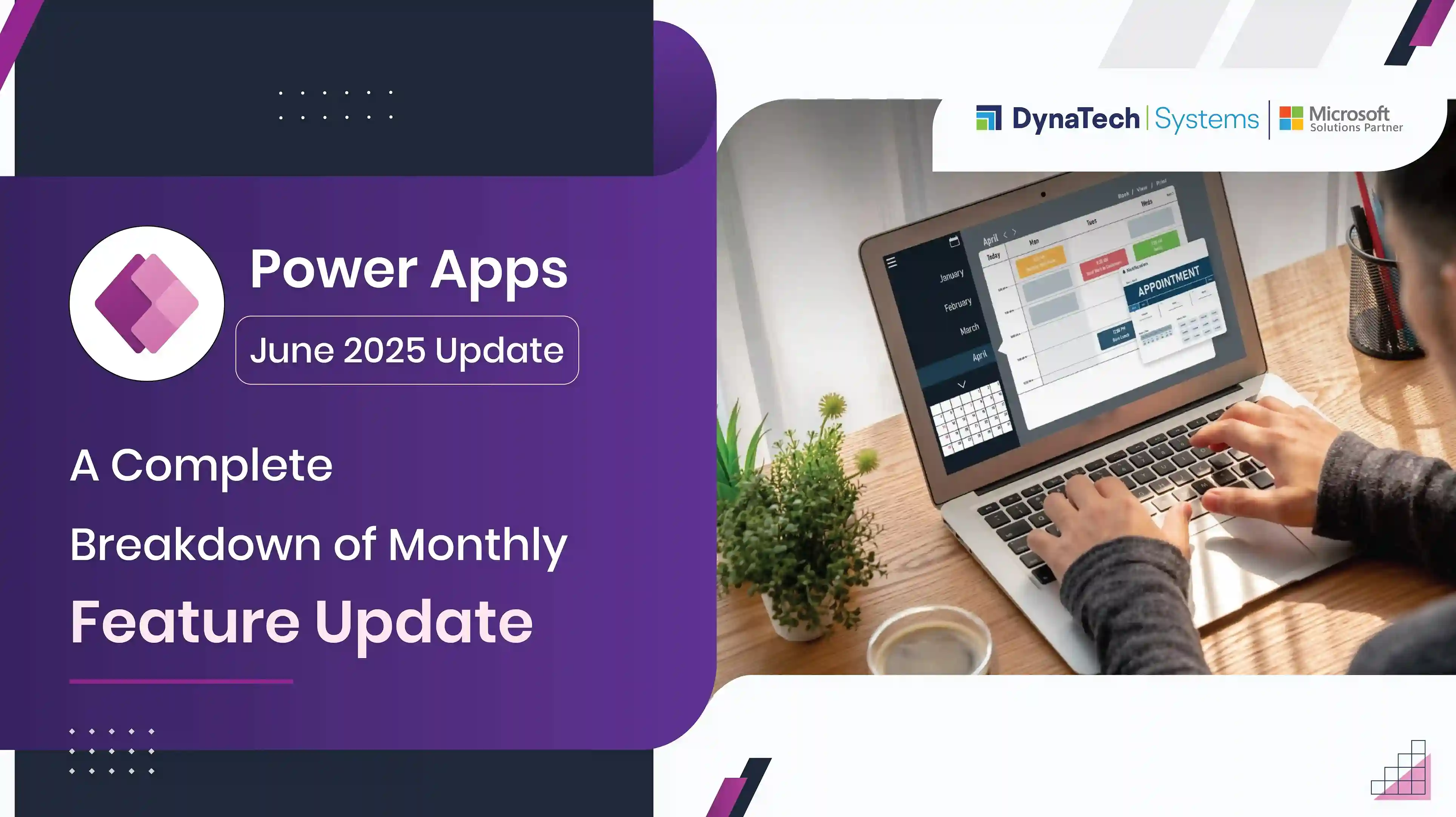Introduction: The Month Power Apps Got Smarter
Every month, Microsoft Power Apps evolves — not with small tweaks, but with purposeful enhancements that redefine how low-code platforms should perform. June 2025 wasn’t just another release. It was a milestone.
The Power Apps June 2025 update brings together a powerful blend of AI-powered development, enhanced design-time experiences, runtime performance upgrades, and tighter integration across the Power Platform suite. This update isn’t just a list of features — it’s a reflection of where enterprise-grade low-code is heading.
Whether you’re a pro-dev, a business user, or a solution architect — the improvements packed in this month’s Power Apps monthly feature update are designed to help you build apps faster, make them smarter, and deliver them at scale with confidence. From Enhanced Component Properties in Power Apps to intelligent control suggestions powered by AI — there’s a lot to unpack.
Let’s break it all down — feature by feature, benefit by benefit.
1. Smarter Components, Faster UIs: Enhanced Component Properties in Power Apps

With the Power Apps June 2025 update, Microsoft has doubled down on making the app-building experience more intuitive and less time-consuming — especially when it comes to reusable components.
This month’s update introduces Enhanced Component Properties in Power Apps, allowing creators to define design-time data for components and test their behavior in isolation — without having to publish and run the entire app. Previously, developers had to rely on runtime testing or workaround controls to see how a component might respond. Not anymore.
Why it Matters:
- Accelerated UI design cycles: Developers can test visuals in isolation before wiring them to real data sources.
- Cleaner architecture: With property definitions tied directly to components, app maintenance and versioning become simpler.
- Improved collaboration: Designers and developers can work on components independently, reducing back-and-forth.
For example, consider building a product card component for an eCommerce app. Now you can predefine test values like “Product Name,” “Price,” and “Inventory Status” directly in the component — without needing an actual backend. It’s mock-driven development made native.
This feature aligns with Microsoft’s ongoing strategy to treat Power Apps components not just as reusable assets but as testable, modular building blocks — much like how frontend frameworks treat UI modules.
Pro Tip:
Use the “Design-time data” setting in the component definition window to test custom inputs and interactions without publishing the entire app.
2. AI-Powered Development Gets Sharper: Control Suggestions, App Generation & More
AI is no longer just a cool addition to Power Apps — it’s the co-creator now.
The Power Apps June 2025 update significantly upgrades Microsoft’s vision of AI-powered development, especially when it comes to helping makers build faster and smarter. The AI Copilot inside Power Apps can now suggest controls based on your intent, auto-generate pages, and even propose logic that aligns with your app’s data context.
This is not just autocomplete for controls — it’s a context-aware assistant that understands what your app is supposed to do and gives you a head start.
What’s New in AI Assistance?
|
Feature |
What It Does |
Who It Helps |
|
AI Control Suggestions |
Recommends form inputs, filters, buttons, and visuals based on schema and app context |
New app makers, UI designers |
|
Copilot-Driven App Generation |
Creates multi-screen apps using natural language prompts and selected data tables |
Business users, non-developers |
|
Data-Aware Expressions |
Recommends formula snippets and expressions using semantic cues from your schema |
Pro-developers, power users |
Real-World Value:
- Fewer clicks, more insights: You tell Power Apps what kind of app you want, and it scaffolds a working prototype — within minutes.
- Smarter logic building: Don’t remember the exact syntax of a LookUp() formula? Copilot offers context-sensitive suggestions.
- AI you can trust: Built with Microsoft’s responsible AI principles, these suggestions are grounded in data context — not just guesswork.
Expert Insight:
As of June 2025, internal benchmarks from Microsoft show a 38% faster app build time for Copilot-assisted sessions vs. traditional design. That’s not productivity hype — that’s measurable acceleration.
3. Performance Boosts Under the Hood: Faster Runtime, Faster Everything
Not all updates come with flashy UIs or AI labels — some are simply about speed. And this month, Microsoft has delivered performance where it counts.
The Power Apps June 2025 update introduces several runtime optimizations that significantly reduce app load times, screen render delays, and unnecessary network calls — particularly in model-driven apps and canvas apps using large datasets.
Microsoft calls it the “Fast Start” architecture — and it's doing justice to the name.
Key Performance Enhancements:
|
Update Area |
What Changed |
Impact |
|
App Boot Time |
Optimized metadata caching, deferred control loading |
Up to 22% faster initial load time |
|
Screen Rendering |
Virtual DOM-based rendering pipeline |
Up to 18% faster screen switches |
|
Data Fetching |
Reduced unnecessary parallel queries |
Lower latency, smoother navigation |
|
Model-Driven Apps |
Improved responsiveness on form edits |
Especially impactful for CRM scenarios |
These enhancements ensure that even data-heavy Power Apps — like those used in field service, logistics, or healthcare — feel significantly lighter and more responsive.

That 1-second difference adds up quickly across hundreds or thousands of sessions per week — particularly in enterprise environments where time translates to cost.
Pro Insight:
Apps using embedded Power BI visuals or connected SharePoint lists are among the biggest beneficiaries of this optimization wave.
4. From UntypedObject to Dynamic: A Naming Shift That Makes Sense

In the world of low-code logic, names matter — especially when you're dealing with types and expressions that form the backbone of your apps. In the Power Apps June 2025 update, Microsoft has officially renamed the UntypedObject data type to Dynamic in Power Fx.
While the functionality remains unchanged, this rename brings the syntax more in line with both common development language conventions (like C#) and how Microsoft connectors describe flexible data.
Why the Rename?
|
Before |
After |
Why It Matters |
|
UntypedObject |
Dynamic |
The term "UntypedObject" was misleading — the type is not untyped, and not always an object. “Dynamic” better describes its flexible behavior and aligns with industry standards. |
This update comes ahead of the general availability of User Defined Functions (UDFs) and User Defined Types (UDTs) in Power Fx. While it’s technically a cosmetic change, it does improve code readability and understanding — especially when building reusable logic blocks or dealing with connectors that return dynamic structures.
What You Need to Know:
- If you’re not using UDFs or UDTs, this change doesn’t affect you.
- If you are using them, you’ll need to update function parameters, return types, or UDT fields from UntypedObject to Dynamic.
- No change in runtime behavior or semantics — it’s just a cleaner naming standard.
It’s a small tweak — but a thoughtful one that reflects Microsoft's focus on improving the developer experience in Power Fx.
5. Original Choice Label Tracking in Public Preview: No More Guesswork
One of the quiet but impactful features in the Power Apps June 2025 update is the audit capability for original Choice data type labels — now available in public preview.
Previously, audit logs only retained the current label of a Choice value, even if that label was modified after the user's selection. So,o if a user originally selected “Red” and the admin later renamed that value to “Pink,” the audit log would misleadingly show “Pink.”
That changes now.
Why It Matters for Auditing & Compliance:
|
Before |
After |
|
Audit logs showed updated label, not the original |
Logs now preserve the exact label selected by the user at the time of input |
This update ensures that audit trails remain true to historical user actions, not post-event edits. It's especially valuable for:
- Compliance-focused organizations where audit logs must reflect actual user input.
- Data integrity use cases, such as customer service disputes or legal documentation.
- Highly dynamic systems where choice fields (like status or priority) are frequently relabeled for business clarity.
Example:
Let’s say your service ticketing app had a “Status” field with options like:
- Open
- Pending
- Closed
If “Pending” was later renamed to “In Review,” previous audit logs would historically show “In Review” — even though the user never saw or selected that term.
With this update, the system retains "Pending" in the audit trail — as it should.
This feature is part of Microsoft’s broader goal of transforming Power Platform into a fully managed, enterprise-grade low-code platform — and audit consistency plays a key role.
6. User Defined Functions (UDFs) in Preview: Reusable Logic for the Win
Power Fx continues to evolve into a full-fledged low-code programming language — and User Defined Functions (UDFs) are one of its most anticipated capabilities. With the Power Apps June 2025 update, UDFs are now in public preview, just a few months away from general availability.
If you're building large, complex apps and repeating similar logic in multiple places, UDFs are about to become your best friend.

What Are UDFs?
UDFs let you write a formula once and reuse it throughout your app — similar to how functions work in traditional programming languages. These functions can:
- Perform calculations
- Retrieve data
- Trigger side effects (e.g., update a record, send a notification)
UDFs are declared using pure Power Fx syntax inside the App. Formulas property, and they live entirely within the app — making them lightweight and app-scoped.
UDFs vs. Enhanced Component Properties (ECPs)
|
Feature |
UDFs |
ECPs |
|
Defined In |
App.Formulas |
Custom Component |
|
Syntax |
Pure Power Fx code |
Configured with dropdowns + formulas |
|
Reusability |
Within same app |
Across multiple apps (via libraries) |
|
Purpose |
Logic centralization |
UI + behavior encapsulation |
So, while both aim to reduce duplication and enhance maintainability, UDFs are ideal for logic abstraction, whereas ECPs focus on modular UI behavior.
Why You Should Try UDFs Now:
- Cleaner apps — no more copy-pasting If, LookUp, or Patch logic in multiple screens.
- Easier debugging and maintenance.
- Increased performance for repeated logic blocks.
Microsoft encourages makers and pro-developers to try out UDFs and share feedback on the Power Apps Experimental Features Forum.
7. Reduced Downtime for Customer-Managed Keys: Security Without the Wait
Security and uptime often have to trade off — but not anymore. The Power Apps June 2025 update brings a critical enhancement that reduces downtime when managing encryption with customer-managed keys (CMKs) in Dataverse.
Until now, applying or reverting a customer-managed key (CMK) triggered a full environment deactivation until all storage services completed re-encryption — a process that could take up to 4 days in some cases. For businesses running mission-critical workloads, this was far from ideal.
What’s Changed?
|
Before |
After |
|
Entire environment stayed offline during full encryption |
Environment comes online sooner, even while encryption is still in progress |
|
Users blocked until all services complete encryption |
Users allowed as soon as core storage encryption completes |
Now, once Dataverse finishes encrypting the core services (those that require downtime), your environment is re-enabled with a new status: “Encrypting – Online.” This means users can access the app, continue operations, and experience zero disruption — while the rest of the encryption finalizes in the background.
Why It’s a Game-Changer:
- Minimized business disruption even during encryption changes.
- Improved security flexibility for regulated industries.
- No more 4-day waits to bring environments back up.
This update reflects Microsoft’s long-term vision to make Power Platform not just a flexible development suite, but a fully enterprise-grade secure platform — on your terms, with your keys.
8. Modern Controls and Fluent Design in Power Apps
User experience isn’t just about aesthetics — it’s about clarity, usability, and speed. With the Power Apps June 2025 update, Microsoft continues to modernize app visuals through refined Fluent Design elements and a richer set of modern controls.
This update adds more consistency, accessibility, and customization to how your apps look and feel — ensuring they align with broader Microsoft 365 design standards and feel native across devices.
What’s New in Modern Controls?
|
Control Enhancements |
Description |
Value |
|
New Visual Styling for Inputs |
Sleeker dropdowns, toggles, text inputs, and buttons with Fluent UI themes |
Improves UX clarity and cross-device consistency |
|
Consistent Font & Sizing |
Typography auto-adjustments across screens |
Cleaner, scalable design |
|
Dark Theme Improvements |
Visual tuning for contrast and accessibility |
Better usability in low-light and mobile contexts |
|
Auto Layout Features |
Responsive grid and alignment behavior |
Faster app building with less manual tweaking |
Users will immediately notice smoother animations, cleaner focus indicators, and uniform styling — whether using canvas apps on mobile, tablet, or browser.
Why This Matters:
- No more “custom styling” overload — modern controls are now expressive and functional out of the box.
- Better accessibility: Improved contrast ratios and keyboard navigation support WCAG standards.
- Brand alignment: Fluent Design ensures your Power Apps match the polished look of Microsoft Teams, Outlook, and other M365 tools.
Developer Note:
If you’re still using classic controls in legacy apps, now’s a great time to switch to modern equivalents. They're faster, easier to manage, and come with better performance and visual fidelity.
This UI revamp isn’t about bells and whistles — it’s about modernizing business applications so they look as smart as the logic that powers them.
Final Thoughts: Power Apps Isn’t Evolving — It’s Leading
The Power Apps June 2025 update is not just a monthly rollout — it’s a strategic signal from Microsoft. A signal that low-code development is entering a new era: smarter, faster, and more secure than ever before.
From AI-powered development and Enhanced Component Properties in Power Apps, to smarter audit logs, User Defined Functions, and reduced encryption downtime — each improvement in this update shows clear intent: make Power Apps the most efficient, enterprise-ready low-code platform on the market.
More importantly, these changes aren’t for the future. They’re live, in preview or GA — and ready for organizations to leverage now.
Why This Matters for You
At DynaTech, being a D365 Partner, we help businesses do more with Power Platform — not just by implementing the latest features, but by translating them into business outcomes. Whether it’s improving app development cycles, enhancing UI/UX, tightening security and governance, or building scalable enterprise-grade solutions — our experts ensure your Power Apps strategy always aligns with Microsoft’s evolution.
Ready to Build Smarter with Power Apps?
If you’re looking to:
- Modernize legacy business applications
- Adopt AI-enabled app development workflows
- Strengthen security and compliance within Dataverse
- Or simply stay ahead of Microsoft’s innovation curve
Let DynaTech be your Power Platform partner of choice.
- Explore our Microsoft Power Platform Services
- Talk to a Power Apps Specialist at DynaTech
Image Sources: https://www.microsoft.com/en-us/power-platform/blog/power-apps/whats-new-in-power-apps-june-2025-feature-update




























